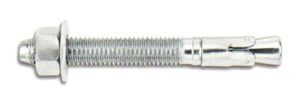Wedge Anchors: It’s Holding Values & Numerous Uses
In generic terms, a wedge anchor is a kind of fastener used to hold a wide range of materials to concrete. It goes in the industry by many other names like:
• Kwik Bolts
• Thunder stud
• Powder stud
But regardless of what name it is called or of what brand it belongs, every single type of this anchor follows the same working principle. Plus, they are more likely to be made with the same basic making materials, which make them similarly in performance too.
Digging Deeper:
A wedge anchor has two detached pieces which are pre-assembled into one single unit, permanently!
I. The first crucial piece is the carbon steel rod which is threaded for a specific part of its length! The end of the anchor that’s installed consists of conical shape or a necked-down diameter tapering outwards and back to its rod’s total diameter.
II. The next important piece of a wedge anchor is its steel slip or sleeve which is assembled at a conical part of its rod.
The interesting thing here is that each wedge anchor needs a washer and nut for its proper installation. And they play a crucial role in numerous applications, provided the base material is durable concrete! They come in a wide range of lengths and diameters, and can be used for performing both lightweight and heavy-weight operations, with ease!
Example: A wedge anchor with A 1/4″ x 1-3/4″ is apt for light-duty applications. And a 1-1/4″ x 12″ anchor deems appropriate for heavy-duty operations.
However, these wedges are suitable for application when dealing with block or brick.

Holding Power:
The holding capacity of a wedge anchor depends on the concrete quality, and as per the rule-of-thumb, it should have a working load of 4.1 (25%) to be regarded as safe!
It holding capacity can also be determined by the embedment depth. Normally, the deeper the embedment, the more its holding capacity!
One key aspect here is ensuring that no two wedge anchors are too closely set together. And the reason being, the pressure exerted can intersect and reduce both the anchor’s holding capacity. The same rules apply when they are placed near any unsupported edge/corner.
Another possibility of placing two anchors too closely to some unsupported corner/edge is the concrete crumbling under the weight of the pressure.
Golden Rules to Adhere:
• When using an anchor with a 1/2″ diameter, it should be at a distance of 2-1/2″ from the unsupported concrete edge.
• Also, two anchors must not be at a distance of 10 diameters from one another. This means two anchors with 1/2” diameter must be kept at 5” distance (at least).
Its Wide Utilities
A wedge anchor serves a lot of utility in vivid constructing applications and heavy-metal use environment- both inside and outside.
It is even great for underwater usage like for swimming pools. However, if this is the purpose of use, then using 304 and 306 stainless steel type of anchors work best!
For plating and extremely dry conditions, zinc plating deems appropriate, while for relatively humid weather conditions hot-dipped galvanised wedge anchor is a wise choice.
For you, the right thing would be to visit quality and reputed wedge anchors supplier in Belcroft Avenue and sort out your appropriate options. Carefully browse through their wedge anchor options and then pick as per the needs!

